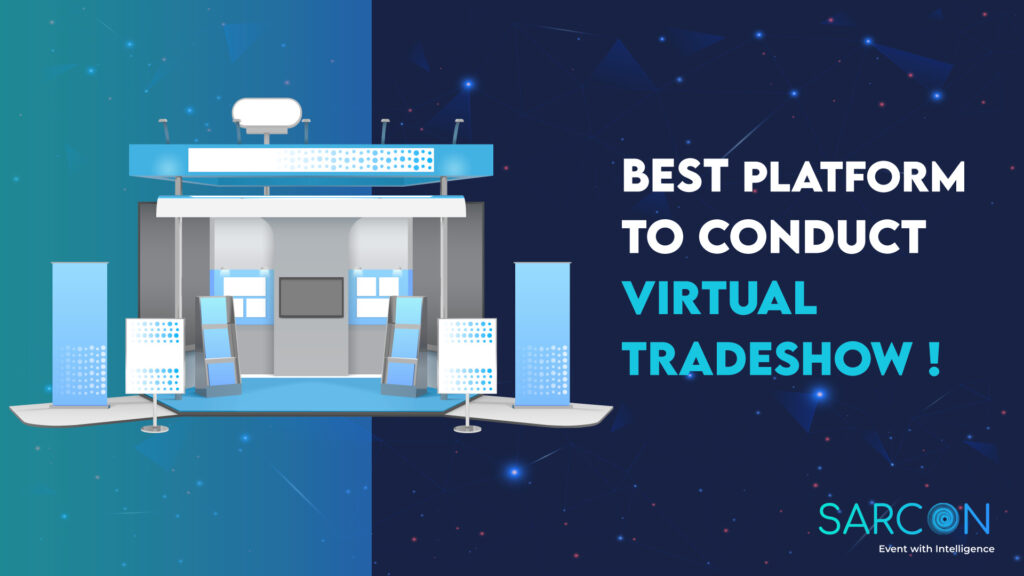Business events and expos have evolved, virtual trade shows have emerged as a game-changing trend. With the advent of innovative virtual trade show platforms, businesses and attendees alike are experiencing a transformative shift in the way they connect, engage, and showcase their products and services.
The Rise of Virtual Trade Shows
The traditional in-person trade show has long been a staple in the business world, offering a platform for companies to showcase their products and services to a targeted audience. However, as the world increasingly turns to digital solutions, virtual trade shows have become the new norm. According to Markletic Event Research 67 % of businesses already rely on virtual events to complement in-person events. These events are hosted on virtual trade show platforms, providing attendees and exhibitors with a unique online experience.
Virtual trade shows have gained immense popularity due to their convenience, cost-effectiveness, and global reach. Attendees no longer need to travel to physical locations, saving both time and money. In this new era of business fairs, attendees can explore virtual booths, interact with exhibitors, attend webinars, and gain access to a wealth of information on products and services, all from the comfort of their homes or offices.
Choosing the Best Virtual Trade Show Platform
Selecting the best virtual trade show platform is crucial to the success of your event. With several options available, it’s essential to consider your specific needs and objectives. Some key factors to keep in mind when making your choice include:
-
Virtual Trade Show Platform Features: Different platforms offer various features, such as virtual exhibit halls, interactive features, and audience engagement tools. Choose a platform that provides the tools necessary to achieve your event goals.
-
Global Reach: Consider the platform’s ability to connect with global prospects. A platform that allows exhibitors to interact with a diverse, international audience can significantly enhance your event’s impact.
-
Ease of Use: Ensure that the platform is user-friendly for both attendees and exhibitors. A complicated interface can deter engagement and lead to a less successful event.
-
Information Accessibility: Look for a platform that allows exhibitors to showcase their products and services effectively. The platform should enable attendees to access information on products and services with ease.
5 Best Virtual Trade Show Platforms
- Sarcon
Sarcon provides a host of features for Virtual Tradeshows. As the platform is designed to be immersive and provide a 3D experience and at the same time convenient to attendees in terms of internet speed, ease of use, engagement, Sarcon is the go-to choice for event pros.
Organizers love their event builder, and the how the pieces of the complex trade show come together. Advanced features like allowing exhibitors to customize their own virtual booths are popular.
- Pros:
- Customizable 3D Environment specifically designed for virtual trade fair, virtual conference, and exhibition.
- Highly Scalable, Enterprise Grade Security
- Customizable exhibit booths including branding, educational materials, and pre-recorded demos.
- Gamification through a leaderboard feature to engage attendees.
- Full Fledged networking for attendees
- Greater branding control for Exhibitors
- A Companion Mobile App
- Support:
- Top-notch support – 24×7 premium support and add-on whiteglove services apart from live and recorded demos
- Pros:
-
- Pros:
- Specifically designed for virtual tradeshows, virtual expo, and job fairs.
- Customizable exhibit booths including branding, educational materials, and pre-recorded demos.
- Gamification through a leaderboard feature to engage attendees.
- Cons:
- Limited real-time interactive features, with only a basic live chat function available.
- Support and Training:
- Offers only phone support and online product demos
- Pros:
-
- Pros:
- Comprehensive features including a powerful event page builder, live streaming, customizable exhibit booths, and in-session polling.
- Deep integrations with marketing automation platforms and CRMs like Salesforce, HubSpot, and Marketo.
- Accessible to both first-time and experienced event planners.
- Cons:
- Virtual event component looks akin to a website
- Support and Training:
- 24/7 live chat, phone, and email support.
- Pros:
-
- Pros:
- Hopin’s user interface, and well-organized layout, which users find intuitive and easy to navigate
- Engagement and networking opportunities through 1:1 chat and group chat features.
- Straightforward pricing model is more affordable compared to other event platforms.
- Cons:
- Lack of Gamification: Gamification is important for attendee engagement in a virtual trade show, this is big downside.
- Limited Integration: There is a noted lack of integration with some external platforms like Salesforce and Interprefy, which could pose challenges for users who rely on these tools
- Pros:
-
GTR:
- Pros:
- Combines webinars and virtual networking for a comprehensive virtual trade show experience.
- Enables real-time meetings between attendees and exhibitors, live product demos, and easy information requests.
- Organizes event information in an easily accessible manner for all participants.
- Cons:
- Pricing is not provided.
- Support and Training:
- 24/7 live rep support, in-person training, live online training, and documentation.
- Pros:
These platforms were chosen based on their features and capabilities specific to hosting virtual trade shows. They offer a variety of tools and features to help create an engaging and interactive environment for both exhibitors and attendees.
Creating an Engaging Virtual Booth
Your virtual booth is the digital representation of your brand. The show floor is also as important for the Virtual experience in an online tradeshow. Just like a physical booth, it should be eye-catching and informative. Here are some tips to create an engaging virtual booth:
-
Branded Virtual Environment: Ensure that your virtual booth aligns with your brand identity. Consistency in branding creates a memorable experience for attendees.
-
Interactive Features: Use interactive elements for booth staff to engage attendees. This can include chat options, virtual product demos, and live Q&A sessions.
-
Information on Products and Services: Make sure that all relevant information on your products and services is easily accessible. Include brochures, videos, and product catalogs.
By focusing on these aspects, your virtual booth can effectively showcase your brand and offerings to a global audience.
Attendee Engagement in Virtual Trade Shows
One of the challenges in virtual trade shows is attendee engagement. Without the physical presence of attendees, it’s essential to employ strategies that keep them actively participating. Here are some techniques to boost attendee engagement:
-
Webinars and Workshops: Offer educational opportunities such as webinars and workshops. These sessions can provide valuable insights and draw attendees into meaningful discussions.
-
Virtual Networking: Facilitate virtual networking sessions where attendees can connect with peers, exhibitors, and sponsors. Building connections is a key benefit of trade shows.
-
Event Experience: Create a dynamic event experience with interactive elements like polls, surveys, and gamification. Encourage attendees to explore and interact.
Webinars and Workshops: Educational Opportunities
Webinars and workshops are valuable components that can be incorporated with the help of your Virtual Event Platform. They provide in-depth discussions, expert insights, and skill development within the context of the online trade show. These educational opportunities enhance the overall event experience for attendees.
Speakers and presenters can share their expertise on industry trends, best practices, and emerging technologies. Attendees have the chance to ask questions and engage in discussions, making these sessions interactive and informative.
Global Prospects: Expanding Your Reach
One of the significant advantages of virtual trade shows is the ability to connect with global prospects. Unlike traditional trade shows, which are often limited to a specific location, virtual events have a borderless reach.
Exhibitors can interact with attendees from around the world, expanding their market reach and exploring international business opportunities. This global perspective is a key driver behind the growth of virtual trade shows.
Hybrid Events: Bridging the Gap
Hybrid events represent a blend of in-person and virtual elements. They bridge the gap between traditional trade shows and their virtual counterparts. Hybrid events allow attendees to choose whether they want to participate in person or virtually, offering flexibility and convenience.
For event organizers who want to maintain a physical presence while also tapping into the benefits of virtual trade shows, hybrid events are an excellent choice. They cater to diverse attendee preferences and provide a broader reach.
The Role of Event Management Software
Event management software plays a pivotal role in the success of virtual trade shows. It streamlines event planning, registration, and management, making it easier for organizers to execute a seamless event. Companies like Sarcon even provide a companion mobile app to complement the virtual event experience.
This software helps organizers manage attendee engagement, track metrics, and provide a user-friendly experience for both exhibitors and attendees. It simplifies the logistical aspects of event planning, freeing up time for organizers to focus on content and engagement strategies.
Best Practices for Virtual Trade Shows
As virtual trade shows continue to gain momentum, it’s essential to adopt best practices to ensure a successful event. Some key best practices include:
-
Planning Ahead: Begin planning your virtual trade show well in advance to allow ample time for preparation and promotion.
-
Clear Communication: Maintain clear communication with exhibitors, sponsors, and attendees to ensure everyone is well-informed about the event.
-
Engagement Strategies: Implement engagement strategies such as gamification, contests, and live polls to keep attendees actively participating.
-
Feedback Collection: Collect feedback from attendees and exhibitors to continually improve future virtual trade shows.
Summary: Taking Your Virtual Trade Show to the Next Level
In summary, virtual trade shows have become a vital component of the modern business landscape. They offer numerous benefits, including cost savings, global reach, and enhanced attendee engagement. Choosing the right virtual trade show platform, creating an engaging virtual booth, and prioritizing attendee engagement are key to a successful event.
With the right strategies and event management software, businesses can harness the power of virtual trade shows to connect with global prospects, showcase their products and services, and drive leads. The future of business fairs is undeniably virtual, and by following best practices, you can take your virtual trade show to the next level and stay ahead in the competitive world of virtual events.



